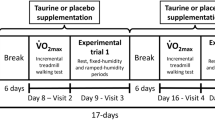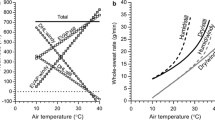Abstract
We tested the hypothesis that menthol application would reduce the magnitude and initiation of sweating via excitation of cold-sensitive afferent pathways and concurrently via a cross-inhibition of heat loss pathways in acclimatized (swimmers, SW) and non acclimatized (control, CON) subjects in cool water. It was expected this effect to be exaggerated in SW subjects. Eight SW and eight CON subjects cycled at 60% of their \( \dot{V} \)O2max, as long as to reach 38°C in rectal temperature (Tre), without or with (4.6 g per 100 ml of water) all-body application of menthol sediment. Heart rate (HR), Tre, sweating rate (SwR), the proximal–distal skin temperature gradient (TSkf–f), and oxygen consumption (\( \dot{V} \)O2) were measured continuously. \( \dot{V} \)O2 and HR were similar between groups and conditions. Menthol increased TSkf–f, Tre threshold for SwR [+0.32 (0.01)°C] and Tre gain, while menthol reduced exercise time by 8.1 (4.1) min. SW group showed higher changes in Tre threshold for SwR [+0.50 (0.01)°C for SW vs. +0.13 (0.03)°C for CON], higher Tre gain, lower time for Tre increase and shorter exercise time [−10.7 (7) min for SW vs. −4.9 (4) min for CON] in menthol condition. Upon exercise initiation, previously applied menthol on the skin seems to induce vasoconstriction, results in a delayed sweating, which in turn affects the rectal temperature. Acclimatized subjects showed higher delay in SwR and earlier rise in Tre, which most probably is due to the inter-group differences in cold receptors activity.


Similar content being viewed by others
References
Bazett HC (1949) The regulation of body temperature. In: Newburgh LH (ed) Physiology of heat regulation and the science of clothing. Saunders, Philadelphia, pp 109–192
Bligh J (1998) Mammalian homeothermy: an integrative thesis. J Therm Biol 23:143–258
Bligh J (2006) A theoretical consideration of the means whereby the mammalian core temperature is defended at a null zone. J Appl Physiol 100:1332–1337
Buono MJ, Sjoholm NT (1988) Effect of physical training on peripheral sweat production. J Appl Physiol 65:811–814
Eiken O, Mekjavic IB (2004) Ischaemia in working muscles potentiates the exercise-induced sweating response in man. Acta Physiol Scand 181:305–311
Geladas ND (1990) Effects of posture and static exercise on heat dissipating mechanisms in humans. PhD dissertation, Simon Fraser University, Canada. http://ir.lib.sfu.ca/dspace/bitstrean/1892/6395/1/b14677453.pdf
Golden FS, Tipton MJ (1988) Human adaptation to repeated cold immersions. J Physiol 396:349–363
Green BG (1986) Menthol inhibits the perception of warmth. Physiol Behav 38:833–838
Green BG (1992) The sensory effects of l-menthol on human skin. Somatosens Mot Res 9:235–244
Hensel H, Zotterman Y (1951) The effect of menthol on thermoreceptors. Acta Physiol Scand 24:27–34
House JR, Tipton MJ (2002) Using skin temperature gradients or skin heat flux measurements to determine thresholds of vasoconstriction and vasodilatation. Eur J Appl Physiol 88:141–145
Jackson AS, Pollock ML (1978) Generalized equations for predicting body density of men. Br J Nutr 40:497–504
Kacin A, Golja P, Eiken O, Tipton MJ, Mekjavic IB (2007) The influence of acute and 23 days of intermittent hypoxic exposures on the exercise-induced forehead sweating response. Eur J Appl Physiol 99:557–566
Kamo H, Honda K, Kitagawa J, Tsuboi Y, Kondo M, Taira M, Yamashita A, Katsuyama N, Masuda Y, Kato T, Iwata K (2008) Topical capsaicin application causes cold hypersensitivity in awake monkeys. J Oral Sci 50:175–179
Leppaluoto J, Korhonen I, Hassi J (2001) Habituation of thermal sensations, skin temperatures, and norepinephrine in men exposed to cold air. J Appl Physiol 90:1211–1218
Linte RM, Ciobanu C, Reid G, Babes A (2007) Desensitization of cold- and menthol-sensitive rat dorsal root ganglion neurones by inflammatory mediators. Exp Brain Res 178:89–98
McMurray RG, Horvath SM (1979) Thermoregulation in swimmers and runners. J Appl Physiol 46:1086–1092
Mekjavic IB, Eiken O (2006) Contribution of thermal and nonthermal factors to the regulation of body temperature in humans. J Appl Physiol 100:2065–2072
Reid G, Babes A, Pluteanu F (2002) A cold- and menthol-activated current in rat dorsal root ganglion neurones: properties and role in cold transduction. J Physiol 545:595–614
Rubinstein EH, Sessler DI (1990) Skin-surface temperature gradients correlate with fingertip blood flow in humans. Anesthesiol 73:541–545
Schafer K, Braun HA, Isenberg C (1986) Effect of menthol on cold receptor activity. Analysis of receptor processes. J Gen Physiol 88:757–776
Shibasaki M, Wilson TE, Crandall CG (2006) Neural control and mechanisms of eccrine sweating during heat stress and exercise. J Appl Physiol 100:1692–1701
Tajino K, Matsumura K, Kosada K, Shibakusa T, Inoue K, Fushiki T, Hosokawa H, Kobayashi S (2007) Application of menthol to the skin of whole trunk in mice induces autonomic and behavioral heat-gain responses. Am J Physiol Regul Integr Comp Physiol 293:R2128–R2135
Yamazaki F, Fujii N, Sone R, Ikegami H (1994) Mechanisms of potentiation in sweating induced by long-term physical training. Eur J Appl Physiol 69:228–232
Yoshida T, Nagashima K, Nakai S, Yorimoto A, Kawabata T, Morimoto T (1998) Nonshivering thermoregulatory responses in trained athletes: effects of physical fitness and body fat. Jpn J Physiol 48:143–148
Acknowledgments
We are indebted to the subjects for their enthusiastic and consistent participation for the completion of the present study. The authors also express their appreciation to Prof Igor B. Mekjavic for his helpful comments in the preparation of the manuscript.
Author information
Authors and Affiliations
Corresponding author
Additional information
Communicated by George Havenith.
Rights and permissions
About this article
Cite this article
Kounalakis, S.N., Botonis, P.G., Koskolou, M.D. et al. The effect of menthol application to the skin on sweating rate response during exercise in swimmers and controls. Eur J Appl Physiol 109, 183–189 (2010). https://doi.org/10.1007/s00421-009-1345-6
Accepted:
Published:
Issue Date:
DOI: https://doi.org/10.1007/s00421-009-1345-6




